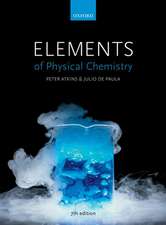A New Unifying Biparametric Nomenclature that Spans all of Chemistry: The science of incorporating daily over 2,000 new names to a base of over 42 million compounds while still maintaining order
Autor Seymour B. Elken Limba Engleză Hardback – 19 mai 2004
- In this book, a new nomenclature system is proposed- The new nomenclature is applicable to a three dimensional world, and is internally consistent- This nomenclature unifies ALL branches of chemistry, removing the need for various presently existing sets of rules
Preț: 1019.57 lei
Preț vechi: 1396.68 lei
-27% Nou
Puncte Express: 1529
Preț estimativ în valută:
195.09€ • 204.24$ • 161.43£
195.09€ • 204.24$ • 161.43£
Carte tipărită la comandă
Livrare economică 05-19 aprilie
Preluare comenzi: 021 569.72.76
Specificații
ISBN-13: 9780444516855
ISBN-10: 0444516859
Pagini: 324
Dimensiuni: 150 x 225 x 18 mm
Greutate: 0.62 kg
Ediția:New.
Editura: ELSEVIER SCIENCE
ISBN-10: 0444516859
Pagini: 324
Dimensiuni: 150 x 225 x 18 mm
Greutate: 0.62 kg
Ediția:New.
Editura: ELSEVIER SCIENCE
Public țintă
Undergraduates in chemistry and their teachers of nomenclature courses, researchers in mathematical chemistry, molecular structure, physical & theoretical chemistry, (in)organic chemistry, polymer chemistry, organometallic chemistry, heterocyclic chemistry, specialists in nomenclature, structure and compound naming, and chemical information specialists.Cuprins
Non-Integer Bonds.Other Significant Difference From Existing Systems.Oxidation Numbers.The Boranes And Related Aluminum Compounds.Spiro And Related Compounds.Topologically Restrained Compounds.Polymers.Molecular Rearrangement.
Recenzii
"introduces a new systematic nomenclature system to provide uniformity. Criteria for nomenclature systems are described rigorously, and this system and existing systems are compared. Applications to a number of areas of chemistry are described in the remaining chapters. Compared to traditional nomenclatures, the system is more of a linear line notation that purports to fully describe the structure of chemical compounds." --R.E. Buntrock, University of Maine, CHOICE Magazine, April 2005








